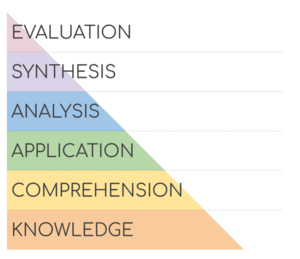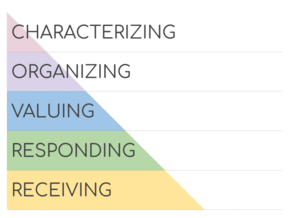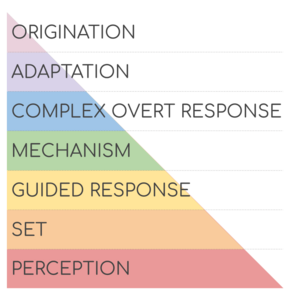Bloom's taxonomy facts for kids
Bloom's Taxonomy is a helpful way to understand how people learn. It's a set of three main ideas that help teachers plan lessons. These ideas show different levels of learning, from simple to more complex. They cover how we think, how we feel, and how we use our bodies.
This system is named after Benjamin Bloom. He was a teacher who led a group of educators. They created these ideas to help make learning goals clear.
Contents
What is Bloom's Taxonomy?
Bloom's Taxonomy helps teachers and students understand different types of learning. It divides learning into three main areas, called "domains":
- Cognitive Domain: This is about thinking, knowledge, and understanding.
- Affective Domain: This is about feelings, emotions, and attitudes.
- Psychomotor Domain: This is about physical skills and actions.
Most schools focus a lot on the cognitive domain. It helps teachers plan what to teach and how to test students.
How Did Bloom's Taxonomy Start?
Educators met between 1949 and 1953 to talk about teaching. They wanted to make it easier for teachers to discuss lessons and tests.
The first part of Bloom's ideas, about thinking (cognitive), came out in 1956. The second part, about feelings (affective), was published in 1964. Later, in 2001, the thinking part was updated to make it even better.
Thinking Skills: The Cognitive Domain
The cognitive domain is all about how we think and process information. The original 1956 version had six levels. The updated 2001 version changed the names slightly and rearranged them. The new levels are: Remember, Understand, Apply, Analyze, Evaluate, and Create.
| Level | What it means | Example |
|---|---|---|
| Remember | This is about recalling facts or basic ideas. You just need to remember information. | Can you name three types of apples? |
| Understand | This means you can explain ideas or facts in your own words. You get the main point. | Describe the differences between a Golden Delicious and a Granny Smith apple. |
| Apply | This is when you use what you've learned in a new situation. You solve problems with your knowledge. | If someone has scurvy (a disease from not enough vitamin C), would eating apples help? |
| Analyze | This means you break down information into parts. You figure out how things connect or why they happen. | Compare different ways to serve apple dishes. Which ones are healthiest and why? |
| Evaluate | This is about judging ideas or information. You decide if something is good or bad based on certain rules. | Which types of apples are best for baking a pie, and why? |
| Create | This is the highest level. You put ideas together to make something new. You invent or design. | Change an unhealthy apple pie recipe to a healthy one. Explain why your new ingredients are better. |
Feelings and Emotions: The Affective Domain
The affective domain is about how we react emotionally. It covers our attitudes, feelings, and values. This domain helps us understand how we connect with what we learn.
There are five levels in this domain, from simple awareness to deep commitment.
| Level | What it means |
|---|---|
| Receiving | You pay attention to something. You are open to hearing or seeing it. |
| Responding | You actively take part. You react to what you hear or see. |
| Valuing | You believe something has worth. You show that you care about it. |
| Organizing | You put different values together. You decide which ones are most important to you. |
| Characterizing | Your values become part of who you are. They guide your actions and beliefs. |
Physical Skills: The Psychomotor Domain
The psychomotor domain is about physical skills. It's about how we use our bodies and tools. This includes things like writing, playing sports, or building something.
Benjamin Bloom and his team didn't create specific levels for this domain. However, other educators, like Simpson (1972), later developed their own.
| Level | What it means | Examples |
|---|---|---|
| Perception | You use your senses to guide your movements. You notice cues around you. | You see where a ball is going and move to catch it. |
| Set | You are ready to act. This includes being mentally, physically, and emotionally prepared. | You know the steps for a task and want to learn a new skill. |
| Guided Response | You are learning a new skill by copying someone or trying things out. You follow instructions. | You follow steps to build a model or copy a dance move. |
| Mechanism | You can do a skill well and with some confidence. The movements become a habit. | You can use a computer or fix a leaky faucet. |
| Complex Overt Response | You perform complex movements smoothly and accurately. It feels natural and takes little effort. | You can parallel park a car easily or play the piano skillfully. |
| Adaptation | You can change your skills to fit new situations. You can adjust what you do. | You can teach a lesson in a new way to help different students. |
| Origination | You create new movements or solutions. You invent something new based on your skills. | You create a new gymnastic routine or a new training program. |
Why Bloom's Taxonomy is Important
Bloom's Taxonomy is very useful for teachers. It helps them plan lessons that challenge students at all levels of thinking. It makes sure students don't just memorize facts. They also learn to apply, analyze, evaluate, and create.
This helps students develop important skills. These skills are needed for understanding information, using technology, and solving problems in the real world.
See also
 In Spanish: Taxonomía de objetivos de la educación para niños
In Spanish: Taxonomía de objetivos de la educación para niños
- DIKW pyramid
- Educational psychology
- Educational technology
- Fluid and crystallized intelligence
- Higher-order thinking
- In Over Our Heads
- Integrative complexity
- Know-how
- Ladder of inference
- Learning cycle
- Learning styles
- Mastery learning
- Metacognition
- Model of hierarchical complexity
- Pedagogy
- Physical education
- Reflective practice
- Rubric (academic)
- Structure of observed learning outcome
- Wisdom




